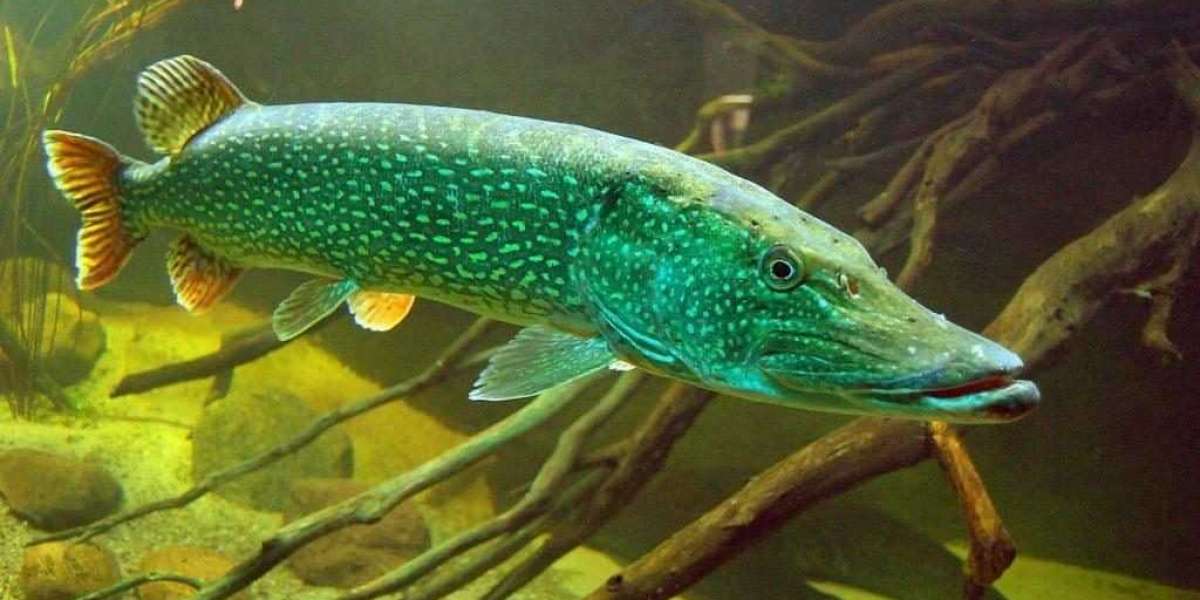This fishing guide from https://dailyfish.ru/ will help you gear up and improve your techniques to land the big one.
Understanding Pike Behavior
Habitat
- Big pike are often found in weedy areas, drop-offs, and deep water structures like submerged logs and rocks.
- They prefer cooler water, making deeper areas or shaded spots ideal in summer.
Feeding Habits
- Pike are ambush predators and often hide in vegetation, waiting to strike unsuspecting prey.
- Their diet includes smaller fish, frogs, and even small mammals or birds.
Best Time to Fish
- Spring: Post-spawn, they are actively feeding in shallower waters.
- Fall: During the pre-winter feeding frenzy, big pike are aggressive and feed heavily.
Essential Gear for Catching Big Pike
Fishing Rod and Reel
- Rod: A medium-heavy to heavy spinning or baitcasting rod, 7–8 feet long, is ideal for handling large pike.
- Reel: A high-capacity spinning or baitcasting reel with a strong drag system.
Line
- Use braided line with a 30-50 lb test strength to withstand the fight and avoid break-offs.
- Attach a steel or titanium leader to prevent the pike’s sharp teeth from cutting the line.
Hooks and Lures
- Large, durable lures that mimic prey fish are most effective:
- Spinnerbaits: Vibrations attract pike from a distance.
- Large jerkbaits: Mimic injured fish, which are irresistible to big pike.
- Soft plastic swimbaits: Perfect for targeting deeper areas.
- Topwater lures: Ideal for shallow areas during low-light conditions.
- Use treble hooks for better hook-ups but handle them carefully to avoid injury.
Techniques for Catching Big Pike
Casting and Retrieving
- Cast toward structures like weed beds or submerged logs.
- Use a stop-and-go retrieve or a steady retrieve with occasional pauses to trigger strikes.
- Experiment with lure speed and depth to find what works best.
Trolling
- Troll along weed edges, drop-offs, or deep channels.
- Use deep-diving crankbaits or attach weights to adjust lure depth.
- Maintain a speed of 2-4 mph, depending on water conditions.
Drift Fishing
- Drift along promising areas like weed beds while jigging or casting.
- Use live bait, such as large minnows, for a natural presentation.
Fly Fishing
- Use oversized streamer flies and an 8-10 weight rod.
- Target pike in shallow water during spring and fall.
Where to Find Big Pike
Shallow Weedy Areas
- In spring and early summer, big pike often hunt near weed beds in 5–10 feet of water.
Deep Drop-Offs
- In midsummer and winter, focus on drop-offs where water transitions from shallow to deep.
Rocky Points and Reefs
- These structures provide ambush points for pike to surprise prey.
Tips and Tricks for Success
- Use Larger Baits: Big pike are drawn to larger prey; use lures 6–12 inches in size.
- Stay Quiet: Reduce noise to avoid spooking the fish.
- Work the Water Thoroughly: Cast in a fan pattern to cover all possible areas.
- Adapt to Conditions: Adjust lure colors and retrieval speeds based on water clarity and temperature.
- In murky water, use bright or flashy lures.
- In clear water, opt for natural colors.
Safety Tips for Handling Pike
- Always use long-nose pliers or a dehooking tool to remove hooks safely.
- Hold the pike firmly behind the gills, but avoid placing fingers in the gill slits.
- Use a landing net to secure the fish and reduce handling stress.
Catching big pike requires patience, preparation, and the right strategy. By understanding their behavior, selecting the proper gear, and employing effective techniques, you can increase your chances of landing a trophy fish. Remember to practice catch-and-release whenever possible to preserve the population of these incredible predators for future generations.




